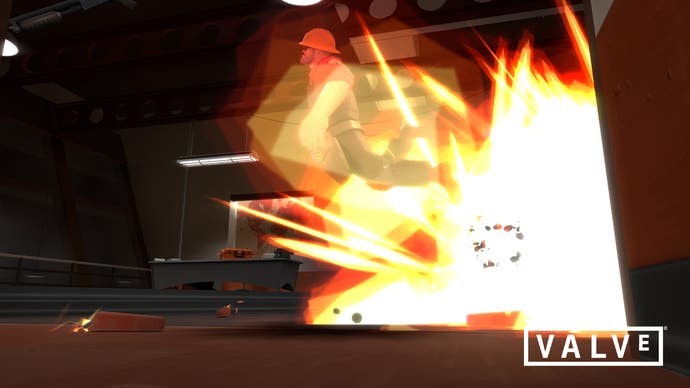Valve's Robin Walker talks TF2
On making Hydro, and what happens after release.
Team Fortress 2 is shaping up to be one of the multiplayer PC games of the year (providing it comes out in this one, obviously). In and around our recent playtest, we were able to ask designer Robin Walker a bunch of questions about the decisions behind it, and the plan going forward beyond release. What follows is a selection of topics raised during the hours we spent in Robin's company, all knitted together fancily so it looks neat and tidy and you can read through it easily. You wouldn't want the raw transcript - it's epic, and we said a lot of stupid things. We're not very clever really. Enjoy.
In the multiplayer space, you're obviously going to retrace your steps a lot, that's what multiplayer's about. Content you're consuming is generated for you by other players; that's what multiplayer is. And so we were thinking about how many maps we should build and so on, and one of the things that anyone who's played online PC games for some time has noticed is that if we build 100 maps it won't matter; the community's going to choose five or six they want to play and play them to death.
Exactly yes, so I think the community's making a good decision there, because if you play 100 maps equally it's really hard for new players to come in and learn 100 maps. If we pick five, new players can come in and really get to know them, so it's just a natural... From our perspective thinking about how we make TF2 more replayable than our previous products, what we thought about was instead of trying to make 100 maps or something, what do we get if we focus on making one map that's more replayable? So we sat down and we tried to design a map that was more replayable. What we came up with is a map called Hydro.

The gist of it is there's four control points out in the middle. Each team has a base, and then there's four points out there in the central area between them. When a map first loads up, these four are randomly distributed; each team gets two of them, but it's not a specific starting set-up, and then the game picks two points that are owned by opposing teams, and carves them out and it spawns everyone in these areas and you can't get out of them. And you fight a short, five-or-six-minute fight over these two points until one team caps the other point, and then that switches those up, and then it picks another round to play from what's available - if blue only has one left they defend that, but the reds could be defending any of the other three.
The game deliberately tries to avoid repetition, so if we've just played two it's more likely to pick two others. Although one other thing it does is, if you were attacking a point it often lets you defend it, because it's often fun to be inside the base you were just attacking. And so this keeps going on until one team owns all the central points, and then they attack the final base, and if the defending team holds out long enough they can get the other point back and it goes on for a while.
They're all completely unique. One's got a large open water area, with bridges. One has a height advantage. This one's all an internal area. This one's like a big satellite and you're fighting inside the dish. This one's half interior half open space. And the way that these connect are all really different too. Here's got a bunch of winding vents, this one has one path through, this one has multiple canyons of high and low. That of course means that if a game can't be resolved in one area, if we switch to this one it has a higher chance of happening because there's a dramatic change in space.
We got snowed in here over Christmas and we played it for about six or seven hours straight, with about 10 of us who couldn't go home, and at the end of it I don't think anyone was saying 'I'm done' or anything. We're pretty damn optimistic about this - we think it's one of the most interesting things we've done in multiplayer maps for years.

We use the same networking system that we've used in the past. TF doesn't really have the same problems that you could have with CS because we're nowhere near as reliant on the scan weapons that CS has; we're more projectile-based. That said, it's sort of a fallacy - the lag thing is actually a fallacy, it's not true at all. The lagged player has no extra ability over...

